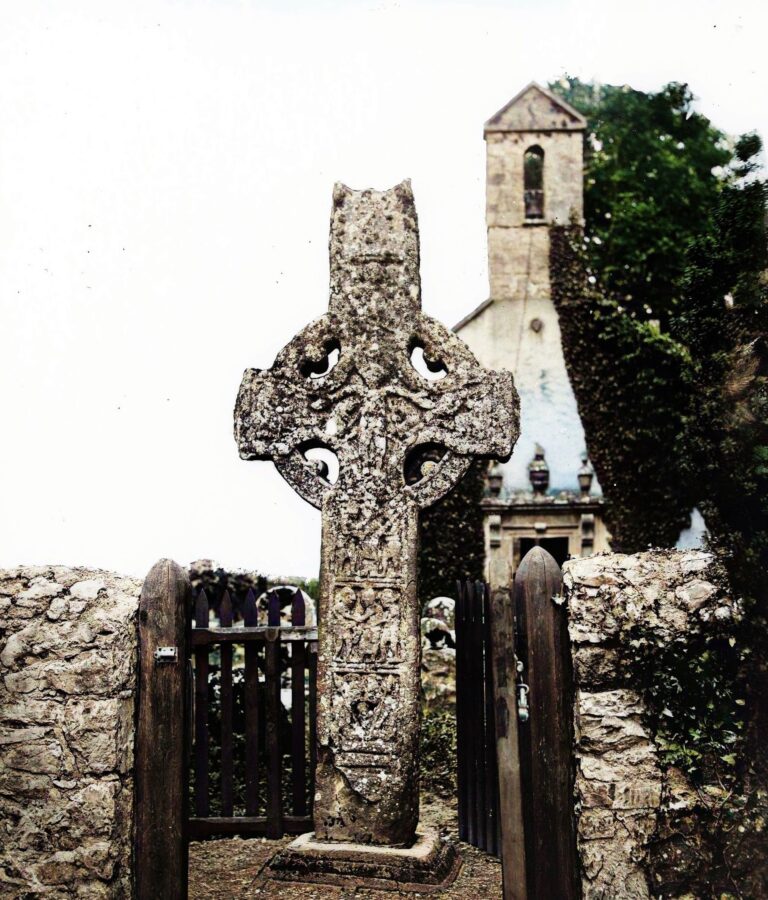Durrow Cross and Abbey, Co. Offaly
Durrow Cross and Abbey, Co. Offaly
Nestled in the heart of County Offaly, Ireland, the site of Durrow Abbey is home to the Durrow Cross, a remarkable example of early medieval Christian art and craftsmanship. This site not only reflects the spiritual and religious life of early Christian Ireland but also showcases the rich heritage of monastic craftsmanship.
Durrow Abbey: Foundation and Historical Context
Founded by Saint Columba, also known as Columcille, around the mid-6th century (approximately 553 or 556 AD), Durrow Abbey is one of the earliest monastic settlements in Ireland. Columba was a pivotal figure in the spread of Christianity in Ireland and Scotland and established several other monasteries during his lifetime. Durrow Abbey quickly became a significant center for religious study and scriptorium work, particularly known for producing the Book of Durrow, an illuminated manuscript predating the Book of Kells.
Durrow Abbey’s role over the centuries was primarily as a center of learning and religious devotion. Despite its prominence, the exact details of any Viking raids or Norman invasions are not well-documented, focusing more on its role in religious and cultural developments.
The Durrow Cross: Detailed Artistic Analysis
The High Cross of Durrow, standing within the preserved churchyard of the Abbey, is an impressive artifact dating back to the 9th century. It measures approximately 3.60 meters in height and is adorned with intricate carvings that are prime examples of Celtic artistry.
Detailed Description of the Cross
- East Face: The head features a depiction of Christ holding a scepter and a cross-staff, traditional symbols of authority and divine rule. This scene is interpreted as representing the Last Judgment. On the sides, the cross depicts a piper and King David playing his harp, while another panel shows David battling a lion, illustrating the harmonization of Old and New Testament themes.
- West Face: This side features an array of biblical scenes including the Crucifixion at the center of the head, surrounded by panels showing the Denial of Peter and Pilate washing his hands. The shaft below includes scenes such as Christ in the Tomb and the Flagellation of Christ, among others.
- North Face: The lower part of the shaft includes an imperfect inscription possibly marking the commissioning of the cross by a local king. It also depicts John the Baptist recognizing Christ in the desert and Elizabeth with the infant John the Baptist, emphasizing narratives from the Gospels.
- South Face: This face illustrates scenes from the Old Testament, such as Adam and Eve, and Cain slaying Abel, as well as David as king, highlighting the cross’s role in educating about biblical history.
Artistic and Cultural Significance
The Durrow Cross is not merely a religious symbol but an artistic masterpiece that illustrates the skill and theological depth of its creators. The carvings serve as a catechetical tool to educate observers about Christian teachings through visual narratives. The craftsmanship reflects the intricate interlace patterns and animal motifs typical of Insular art, showing a deep understanding of both artistic form and religious function.
Preservation and Continuing Legacy
Today, the Durrow Abbey site, along with the High Cross, is a focal point for those interested in Ireland’s monastic past. The preservation efforts at the site help maintain the cultural and historical integrity of this significant monument. The site not only highlights Ireland’s monastic heritage but also its commitment to cultural preservation.
Conclusion
The Durrow Cross and Abbey encapsulate a significant era in Ireland’s ecclesiastical history, serving as a testament to the country’s rich heritage of religious art and monastic scholarship. As enduring symbols of Ireland’s historical and artistic legacy, they continue to draw interest and admiration from around the world, bridging the past with the present in the narrative of Irish culture.

Did you find this helpful?
IrishHistory.com is a website that relies on community contributions to help make it better. If you have a suggestion to improve this page, or have spotted any errors, please click ‘Suggest an Edit’
